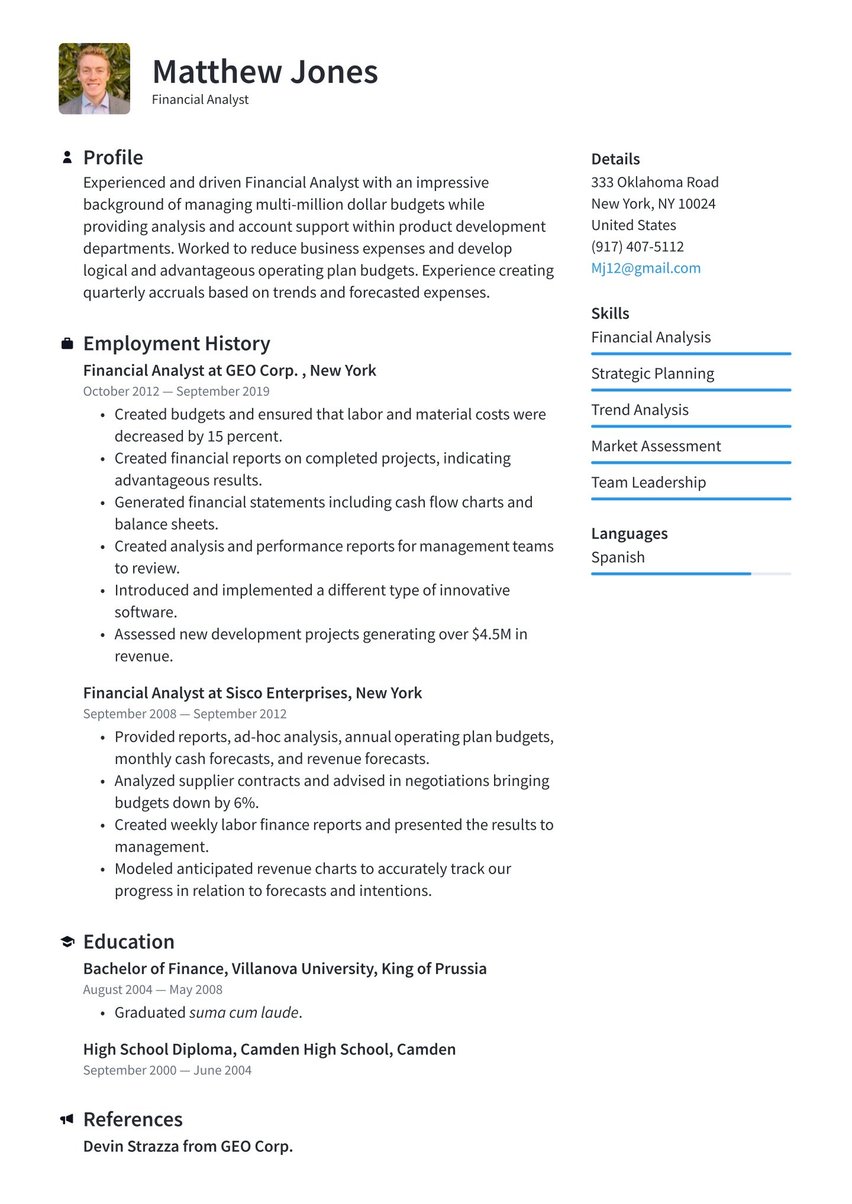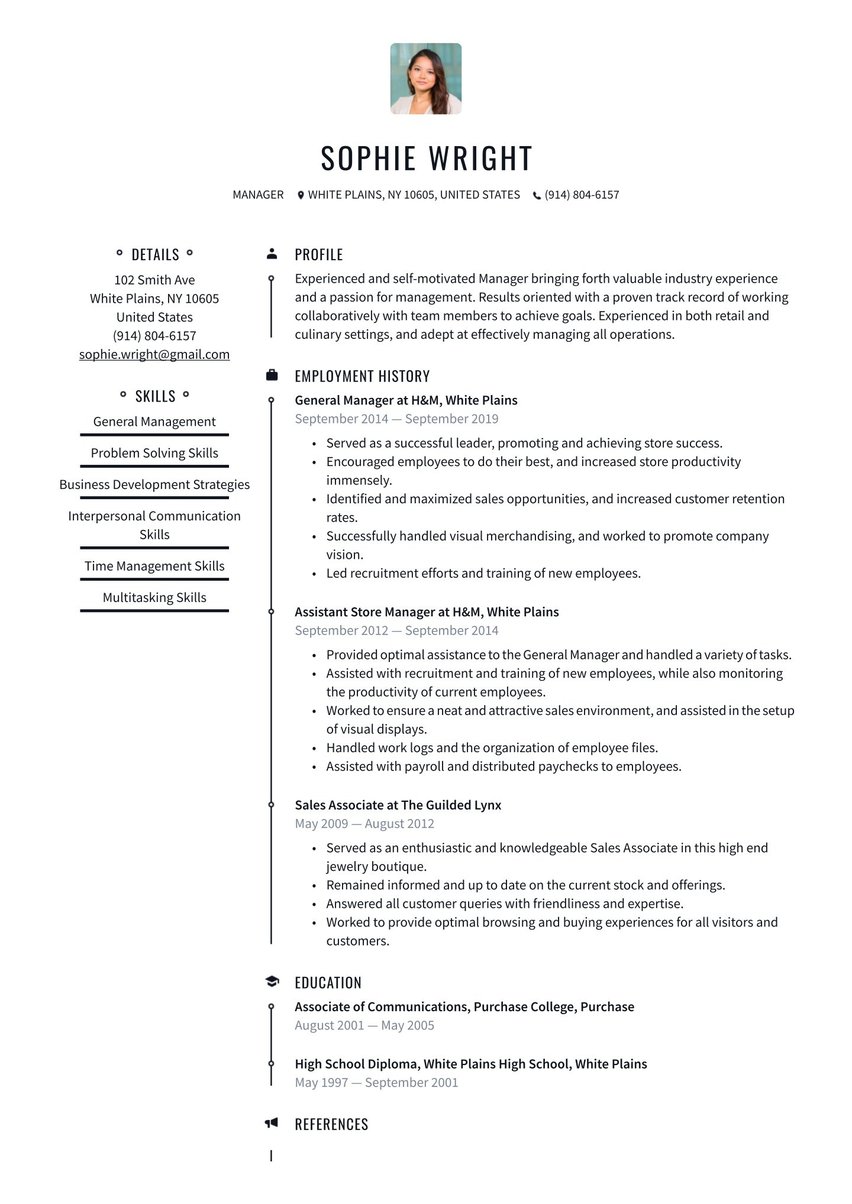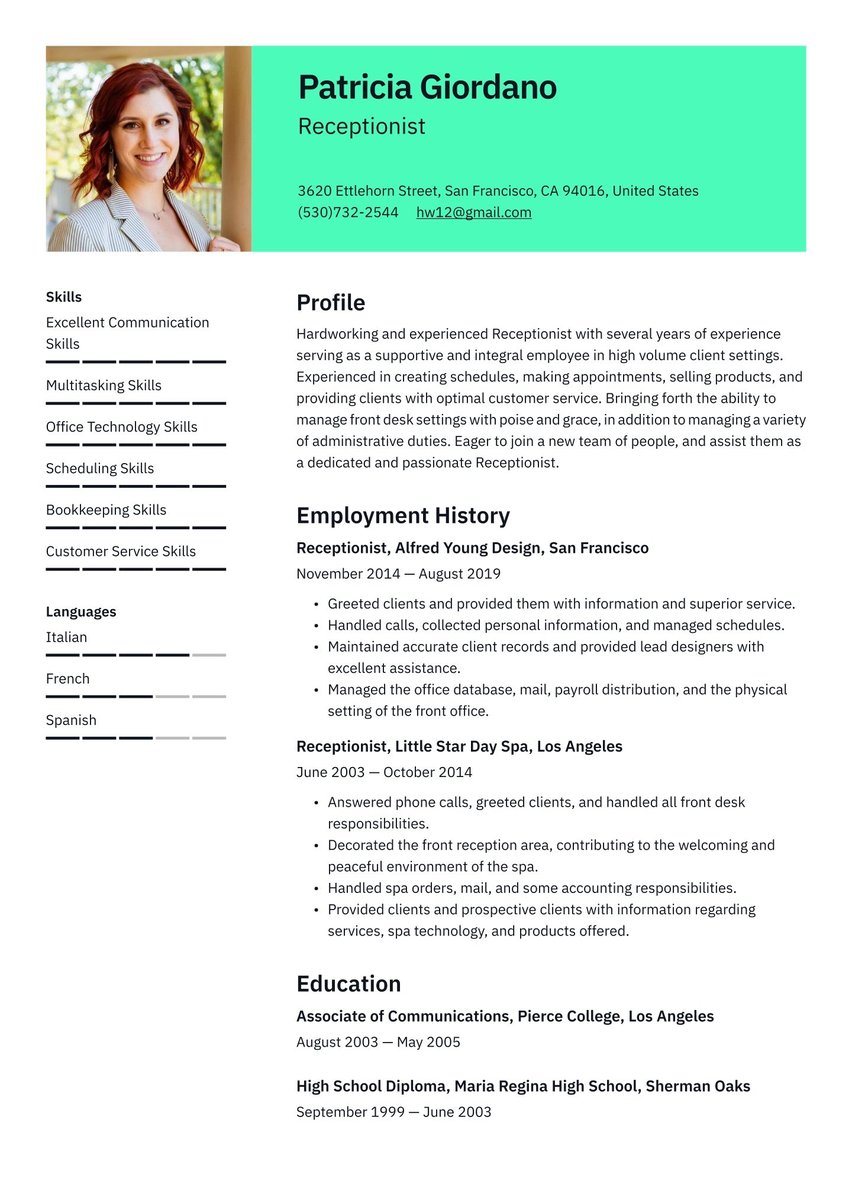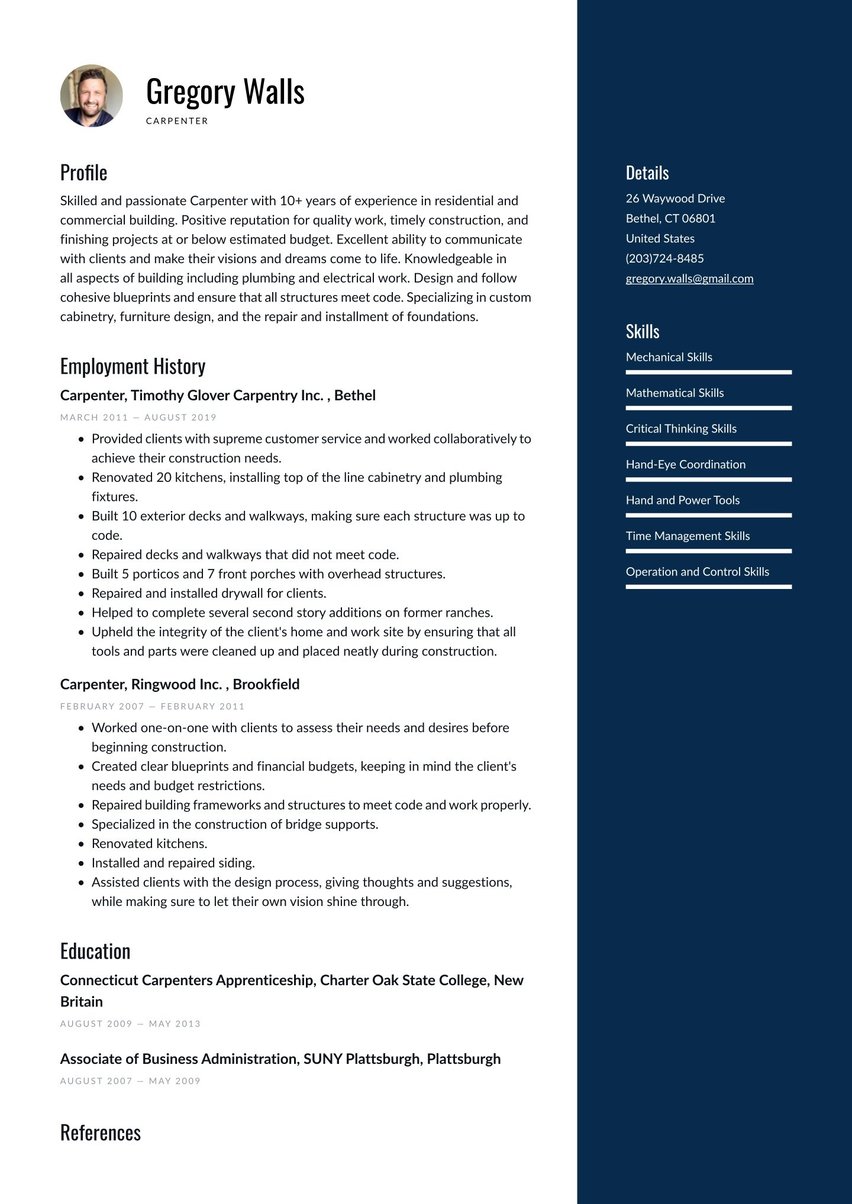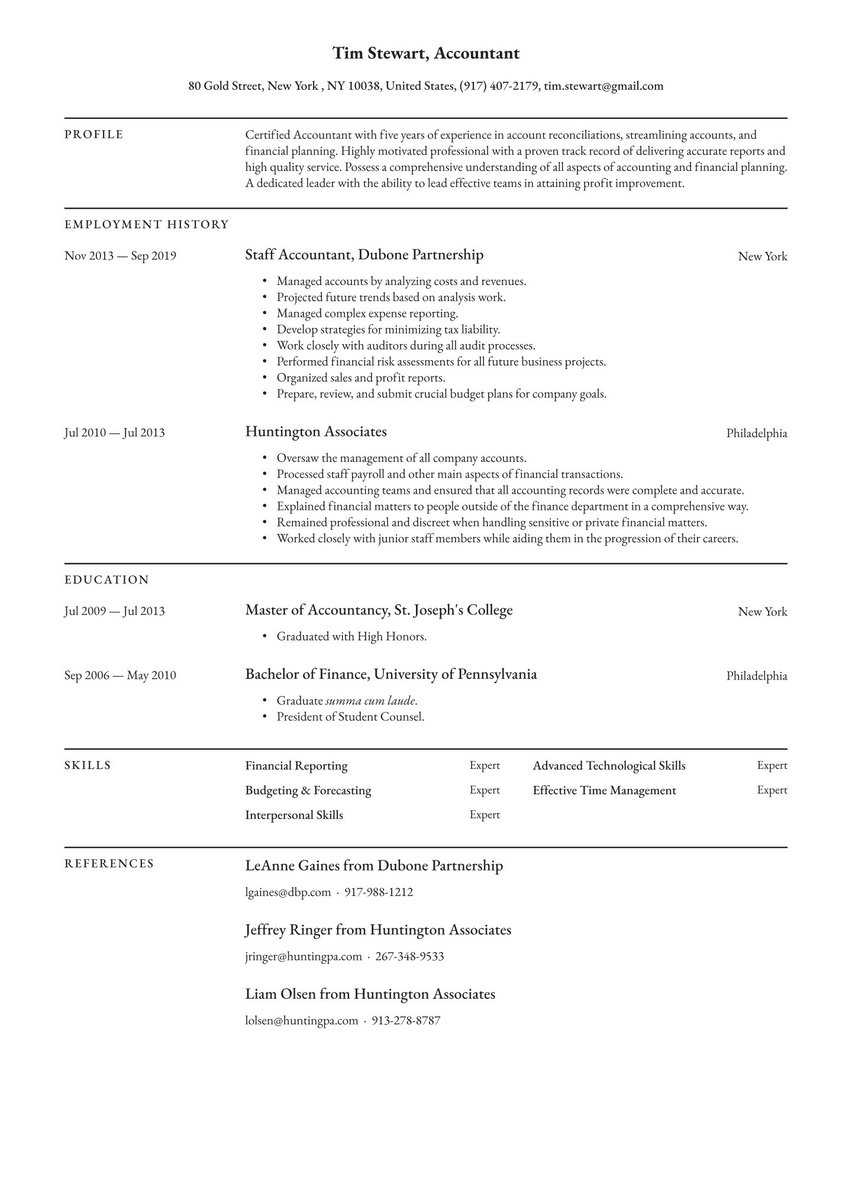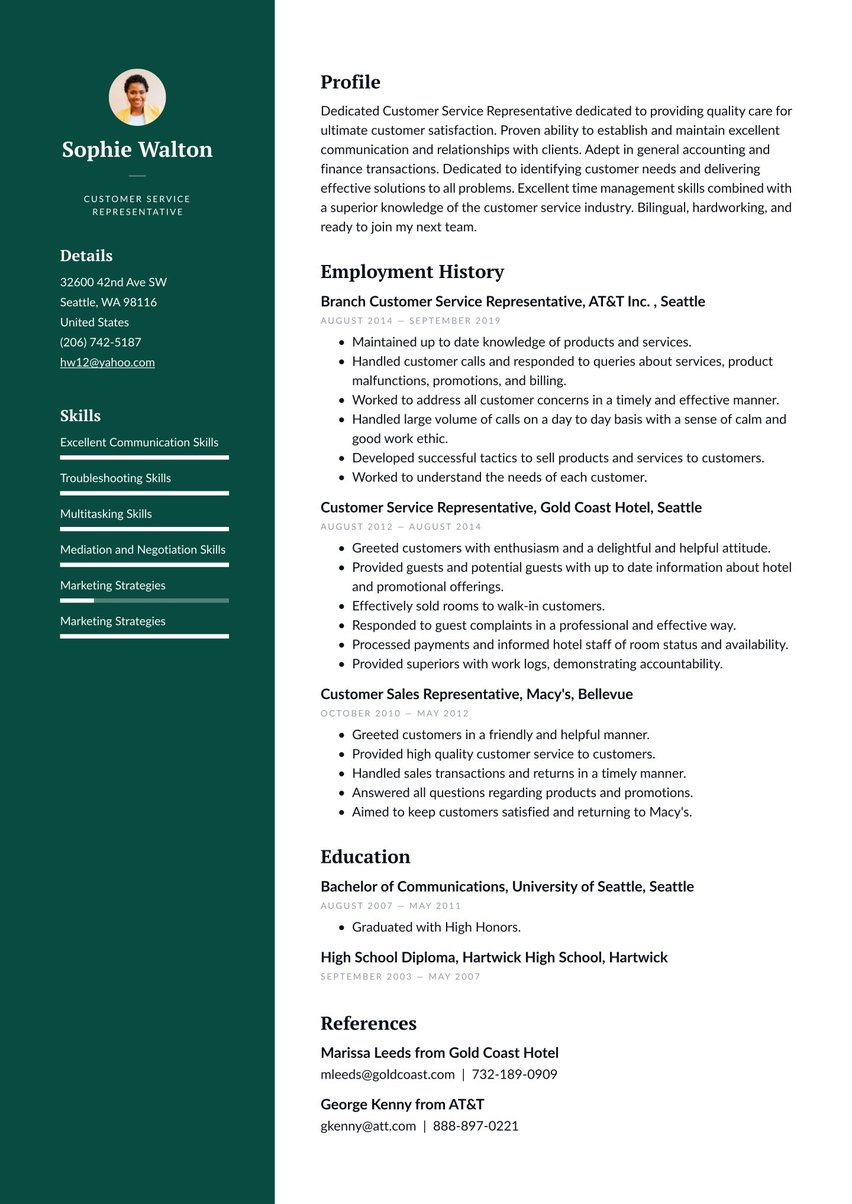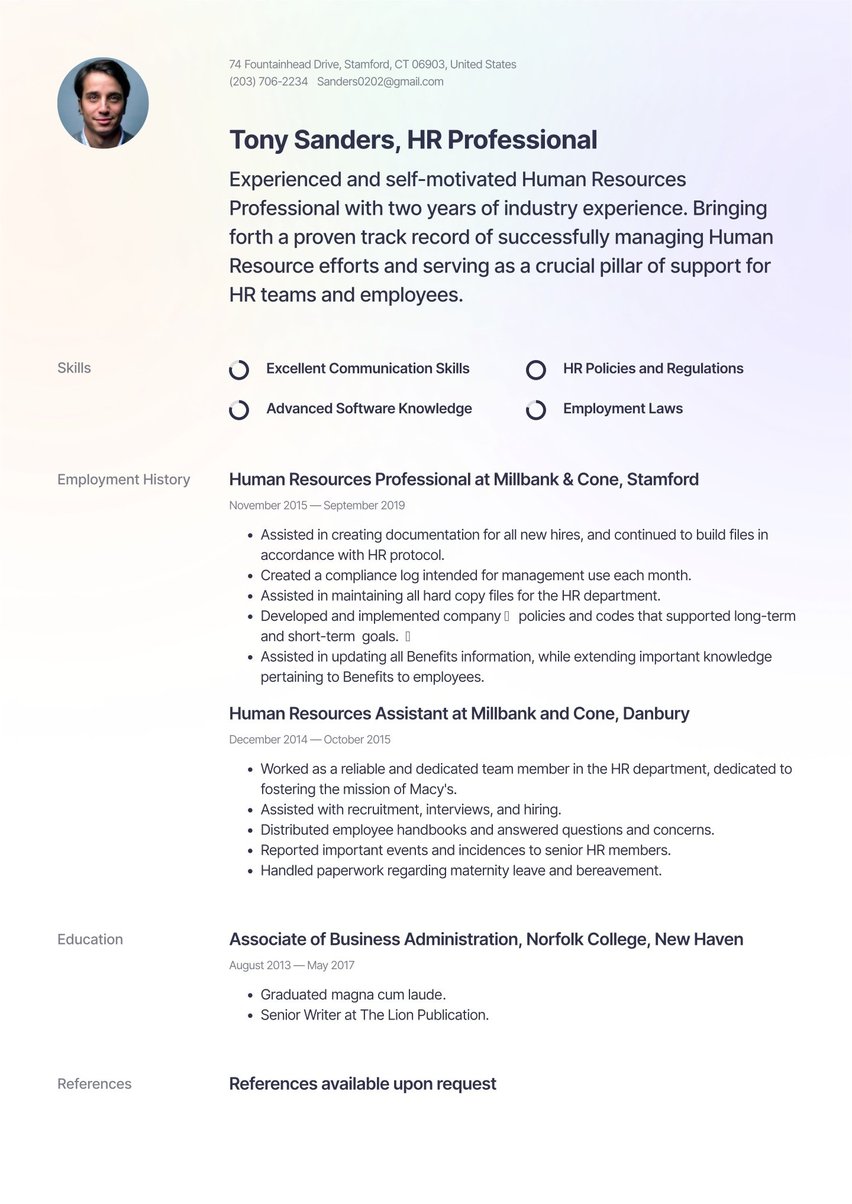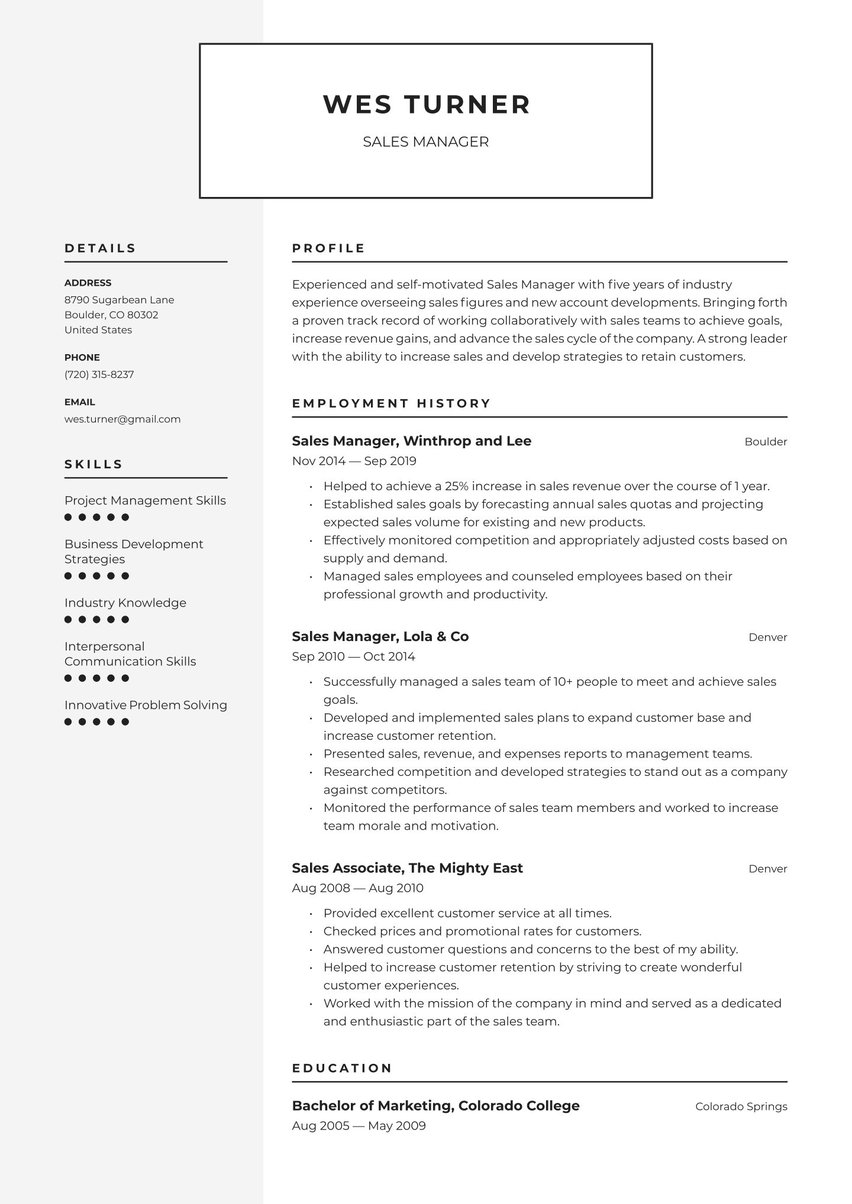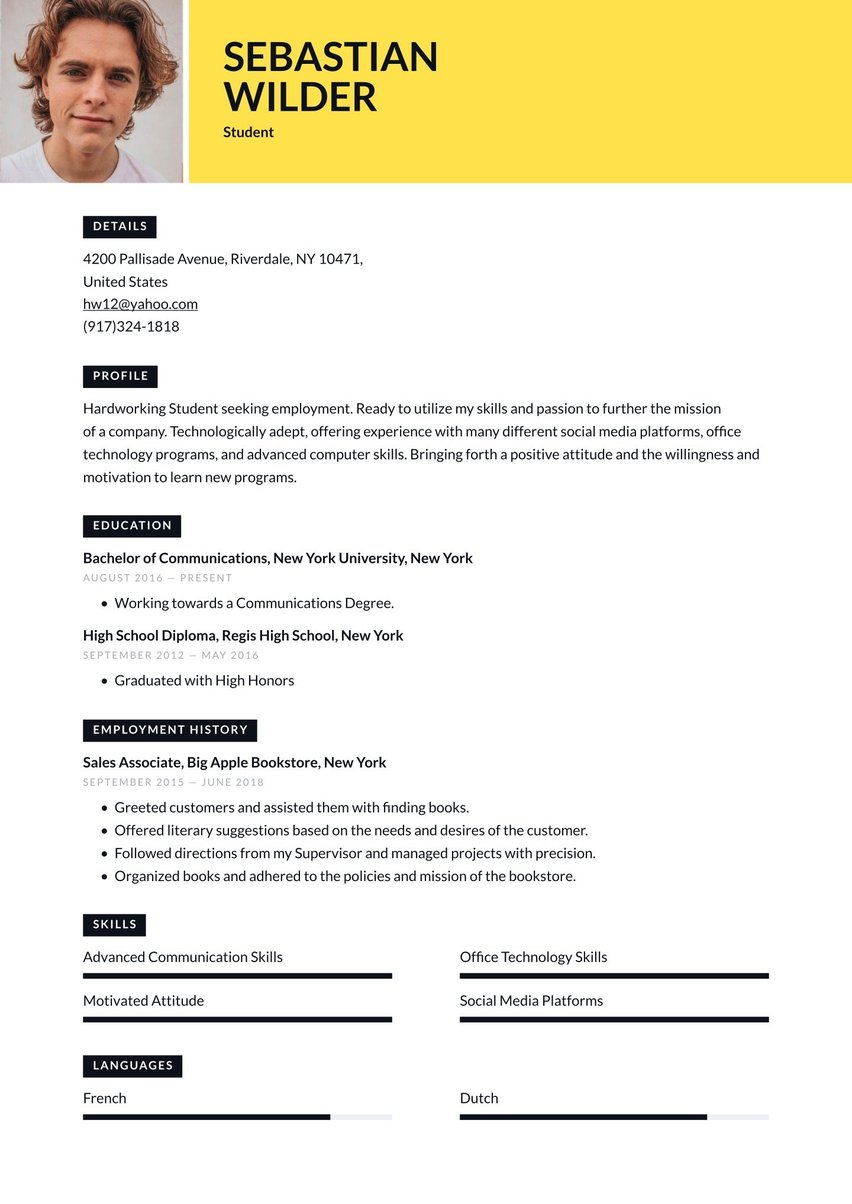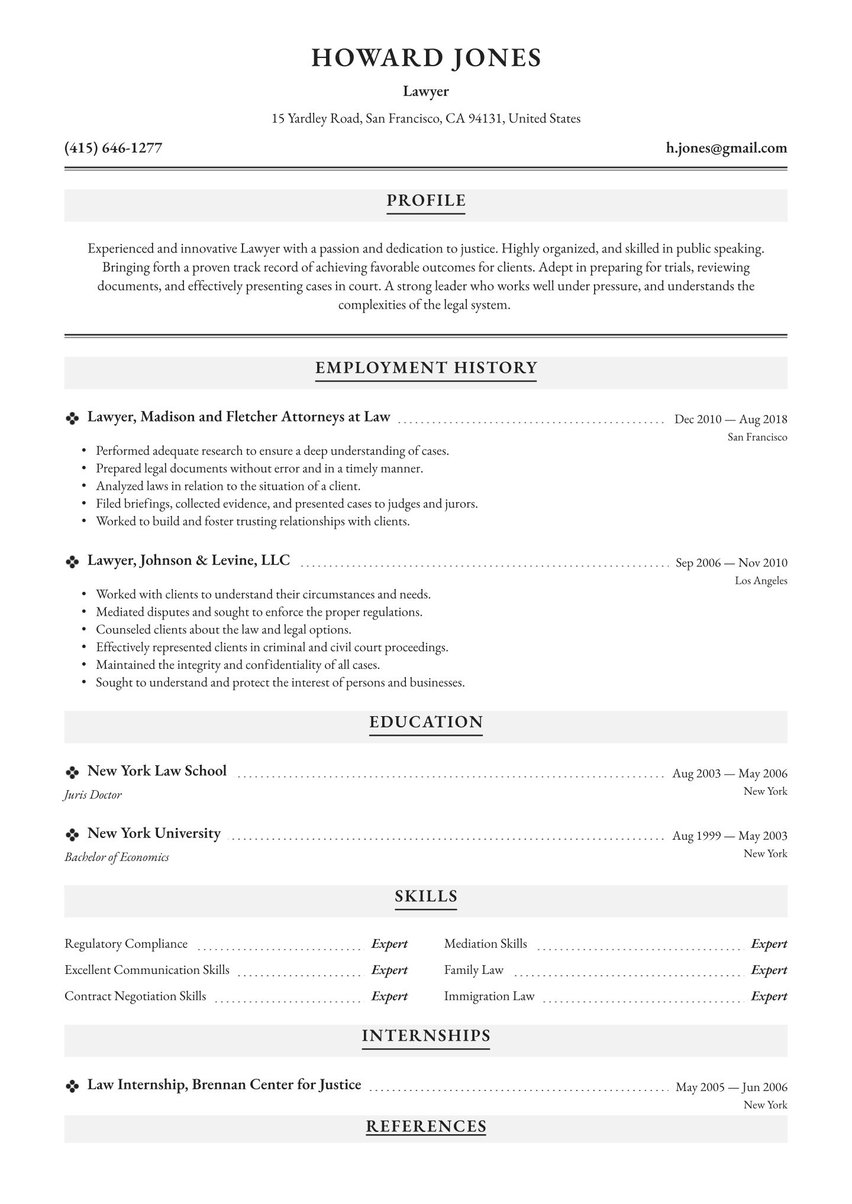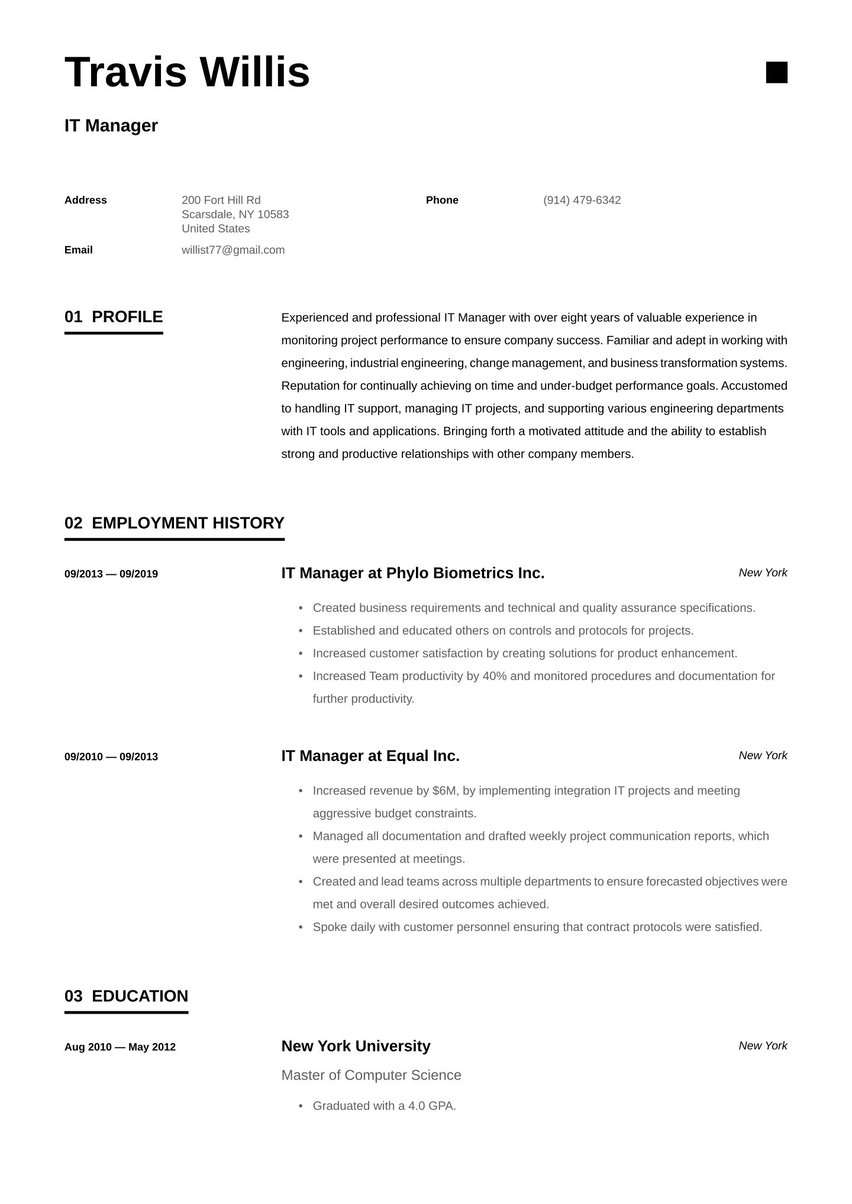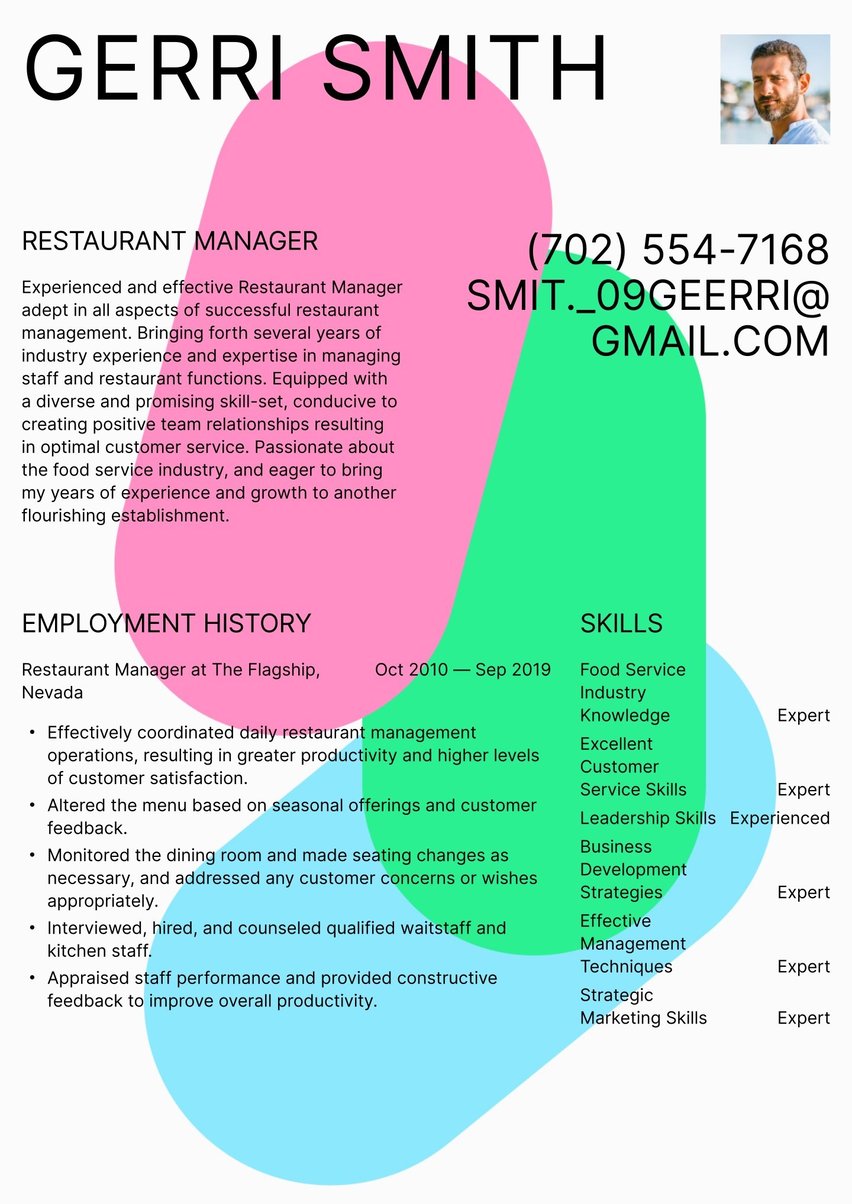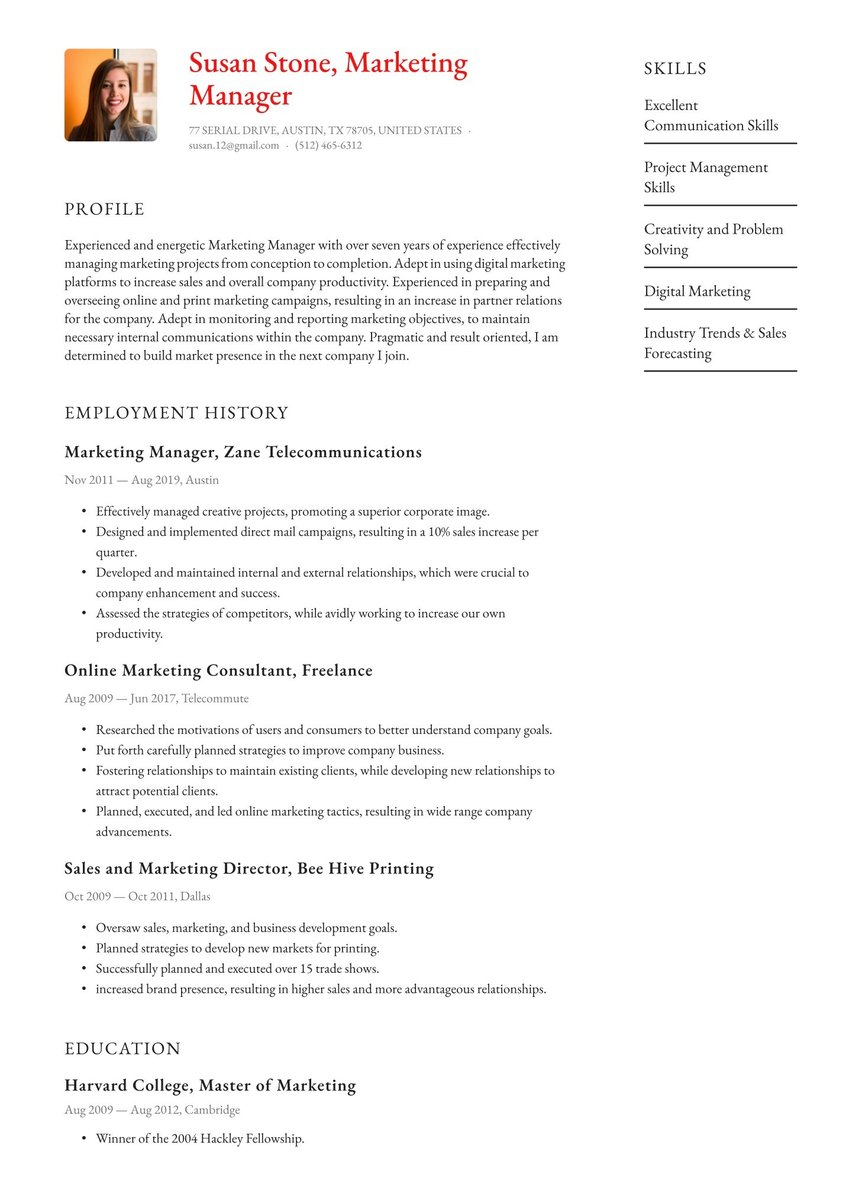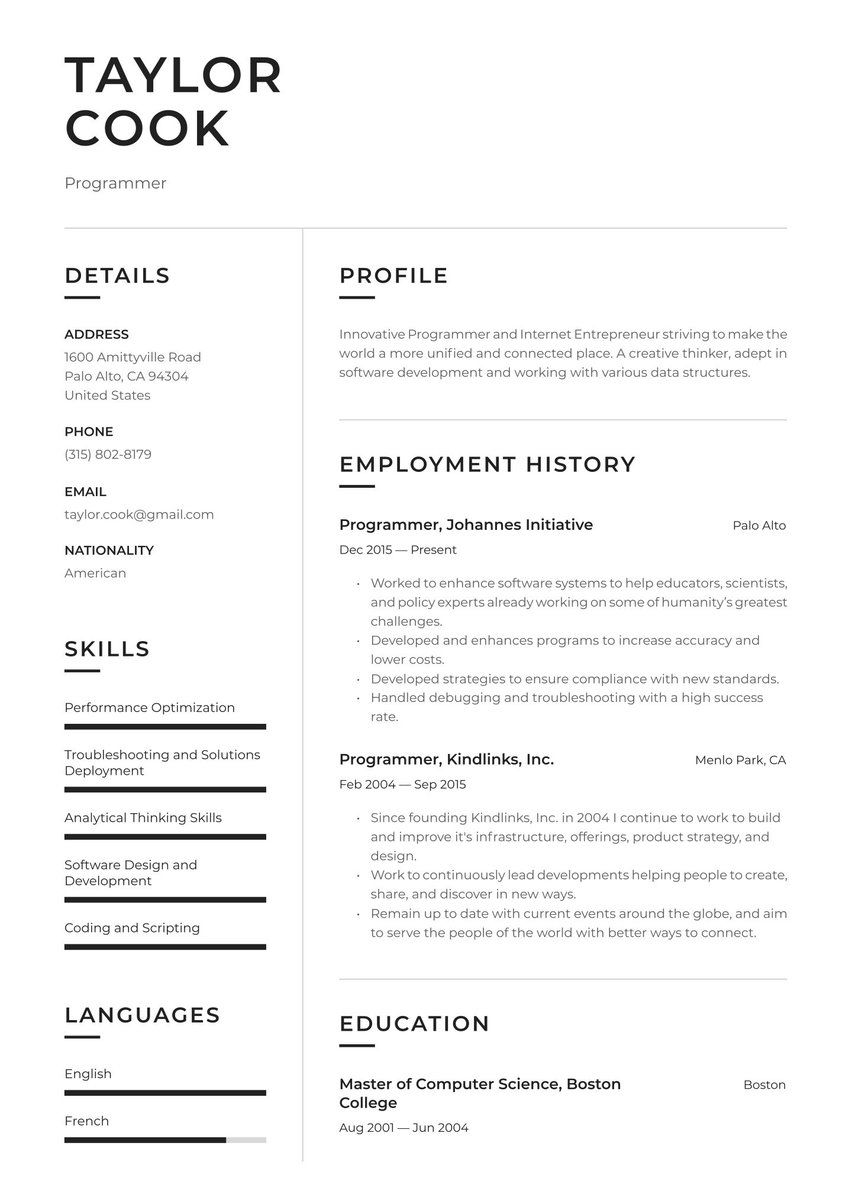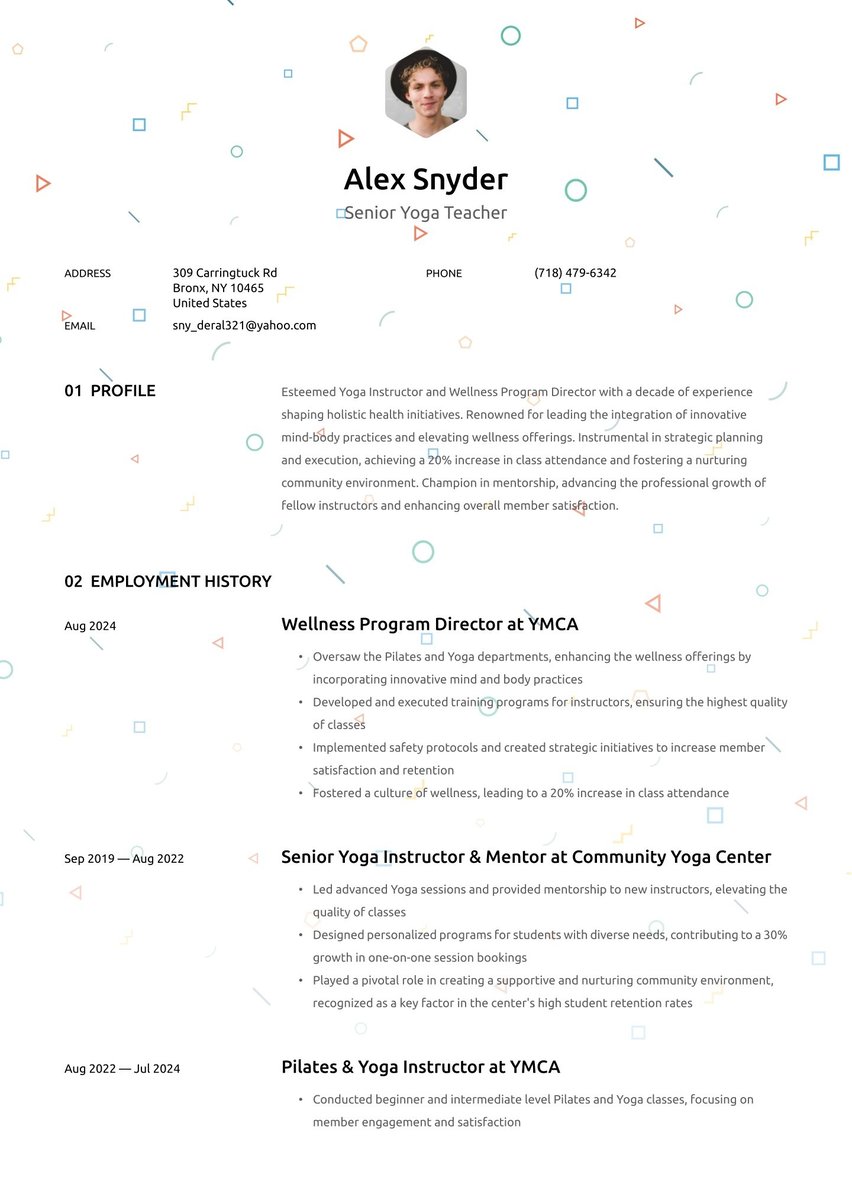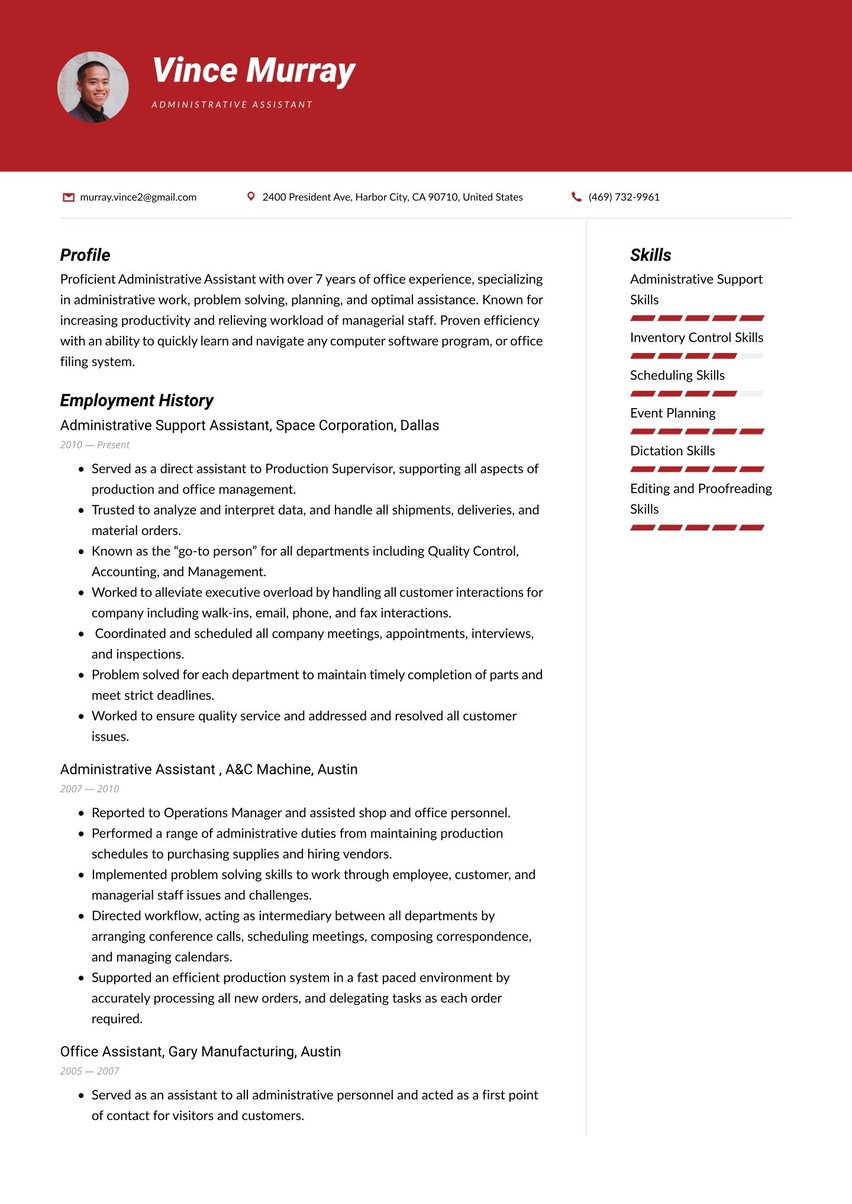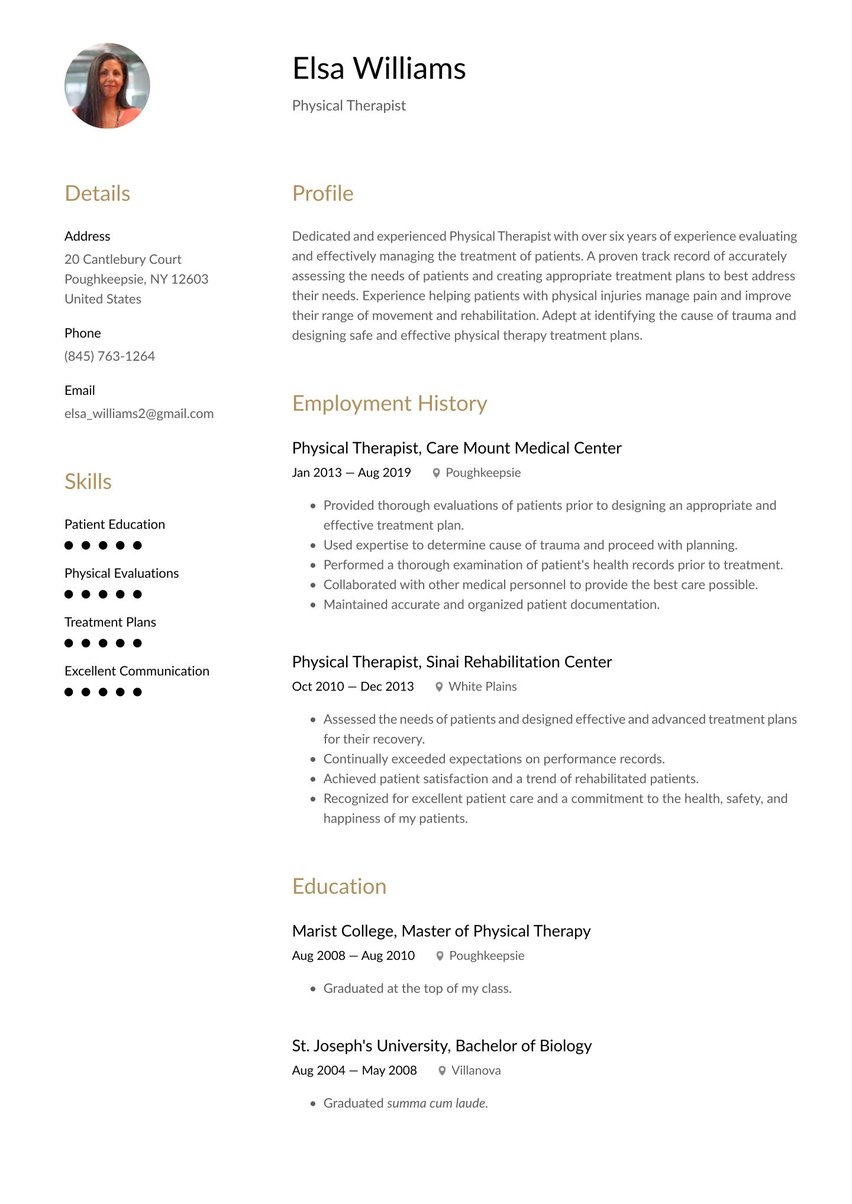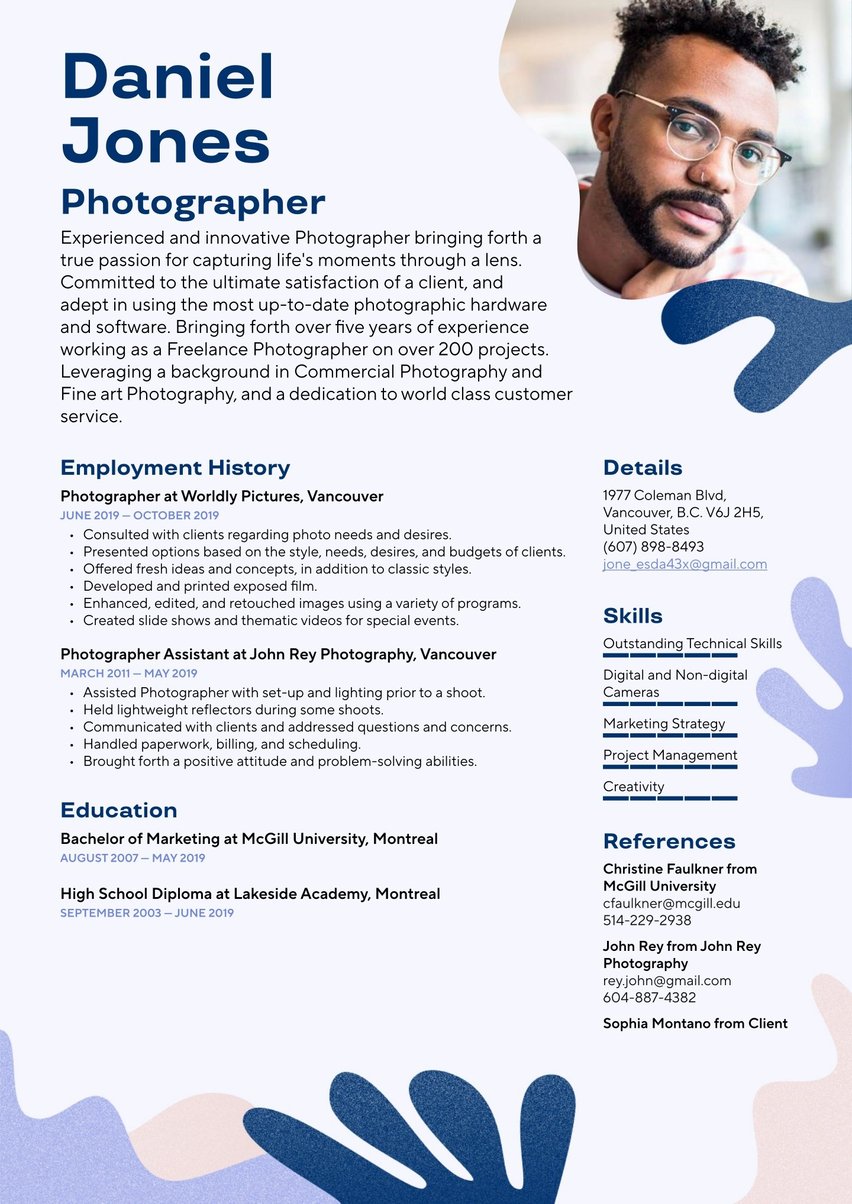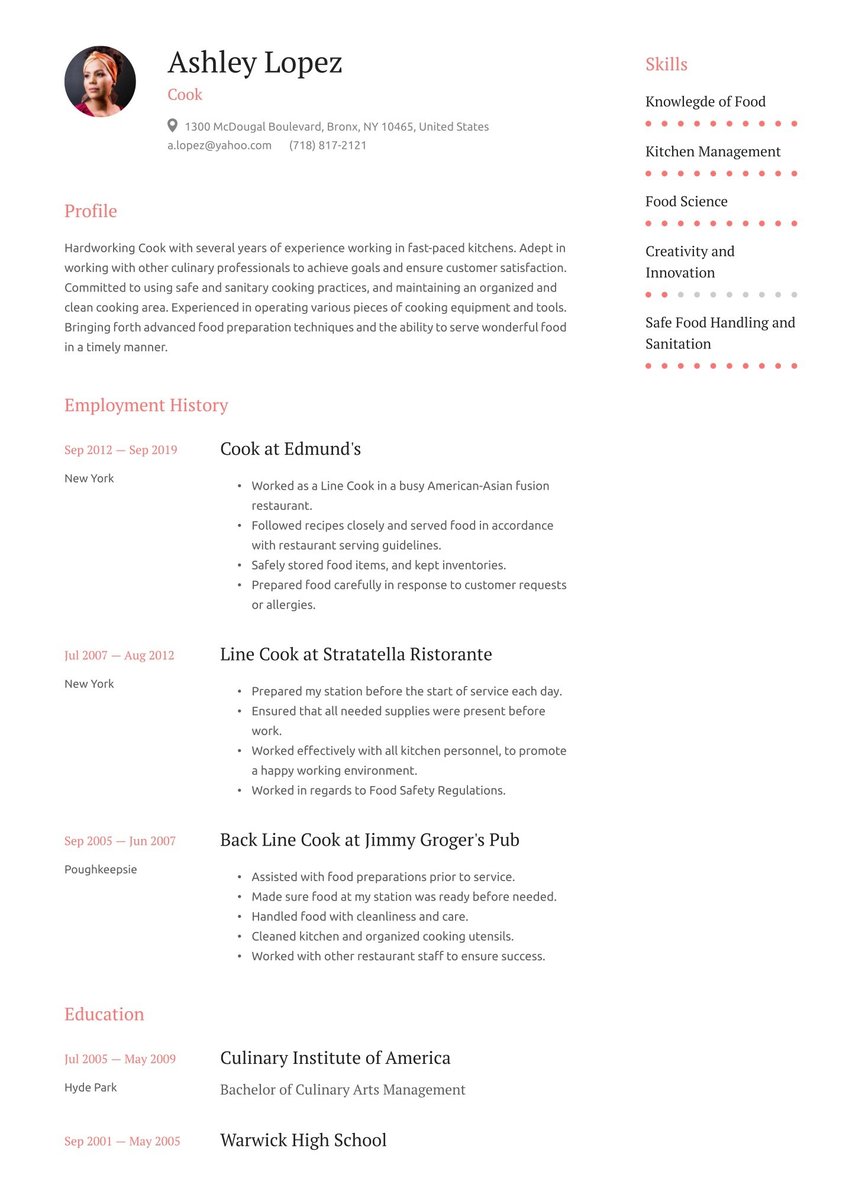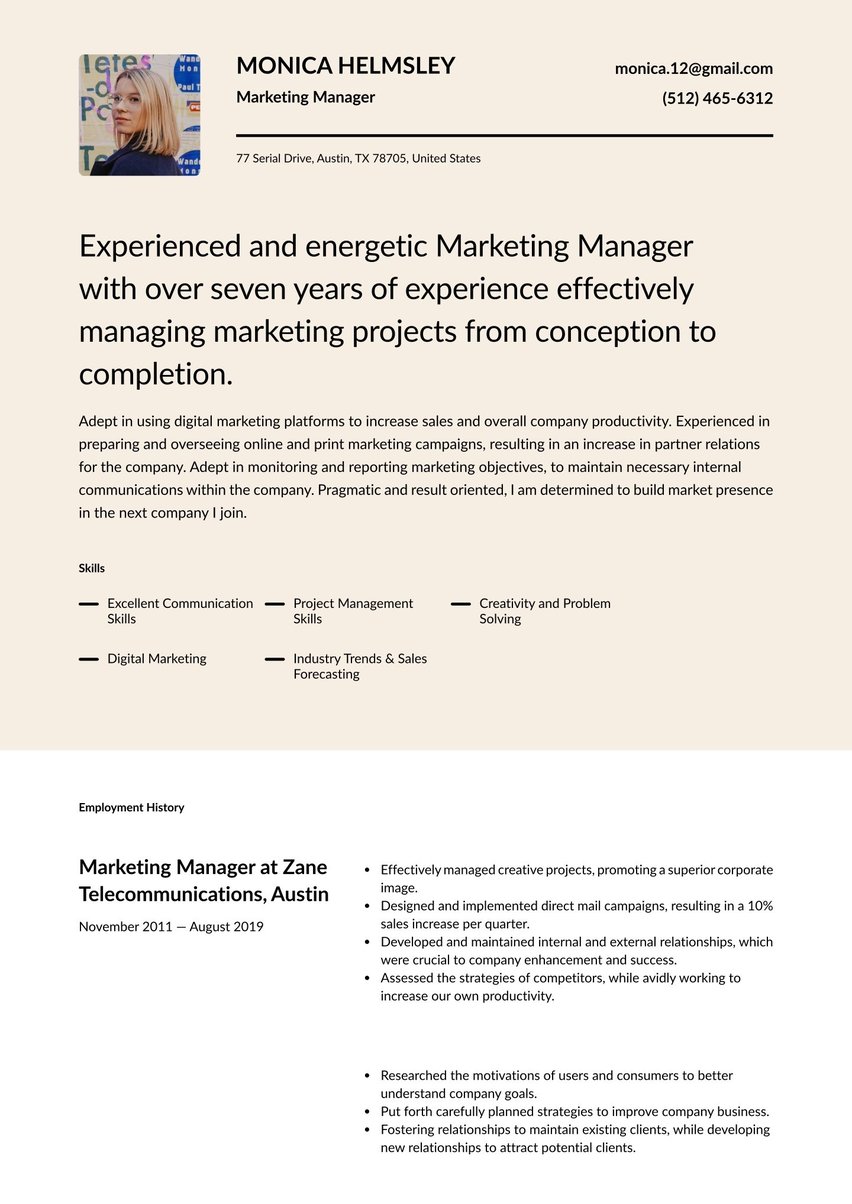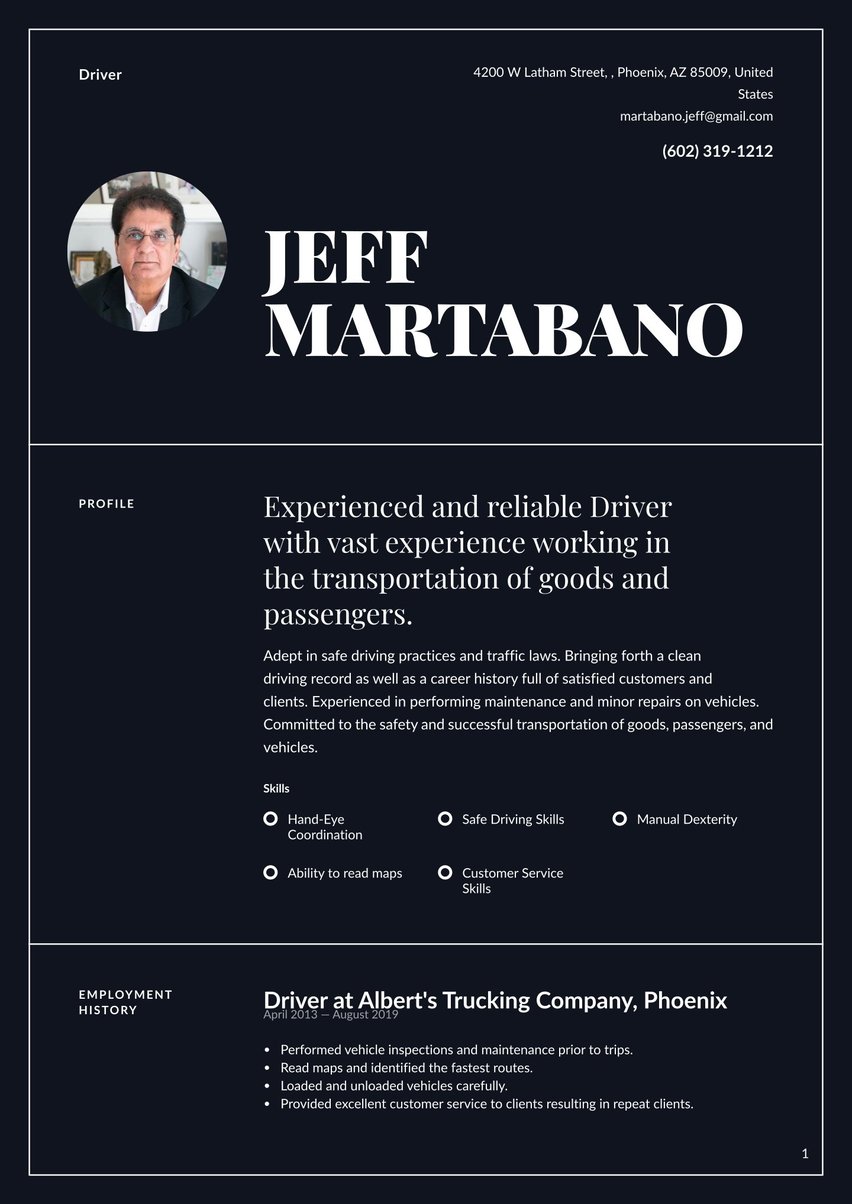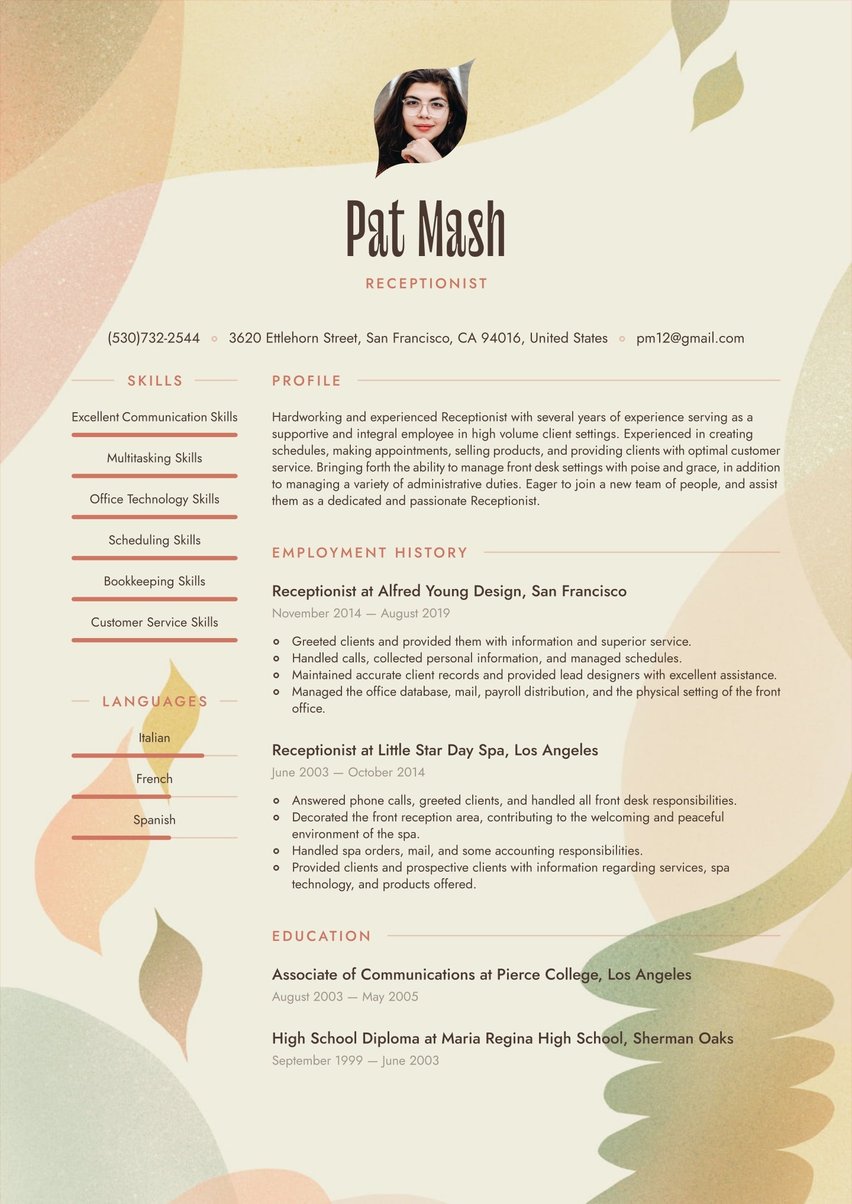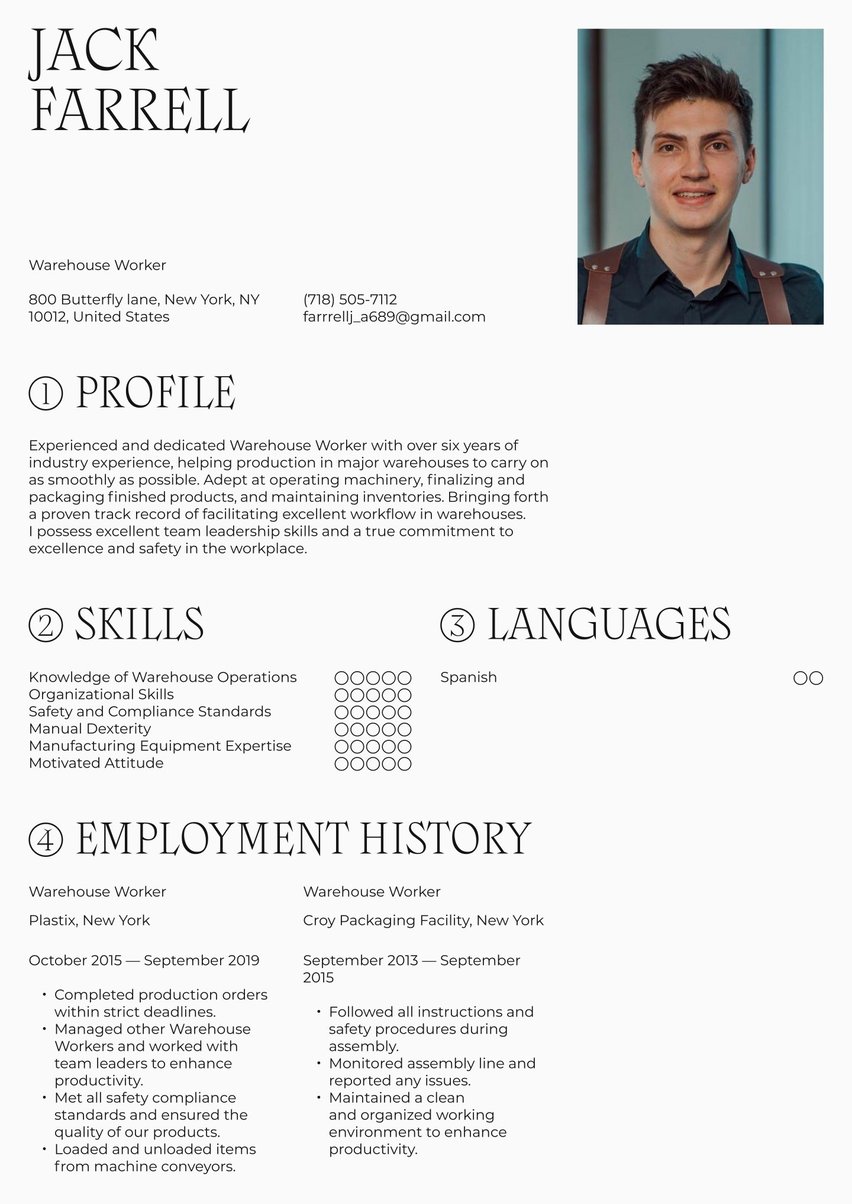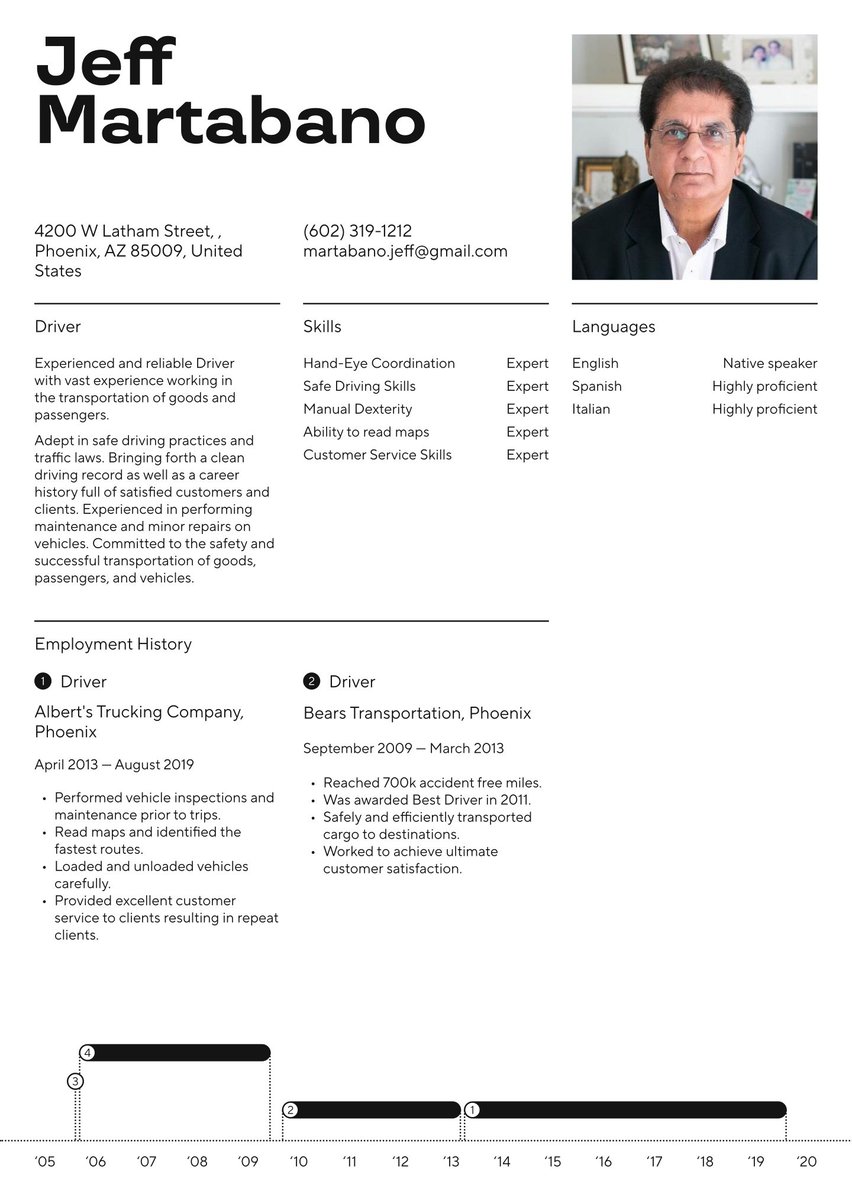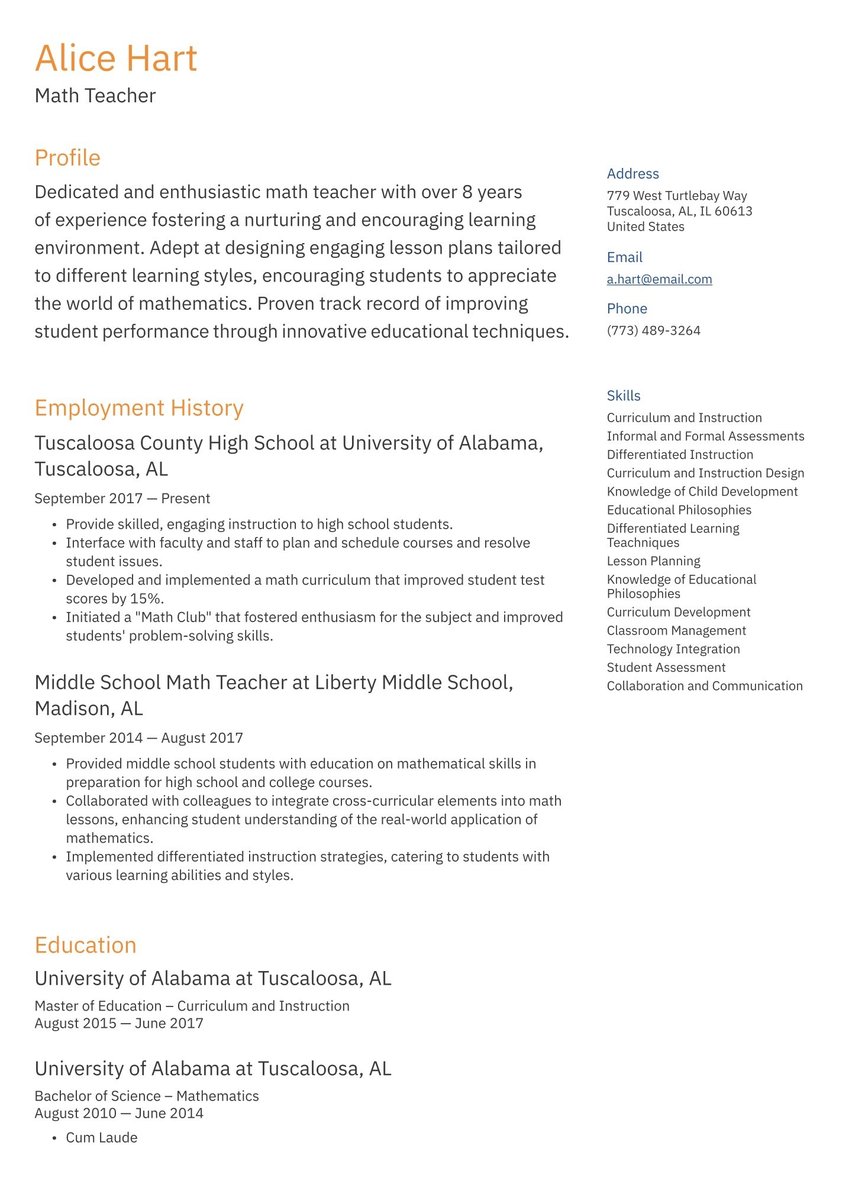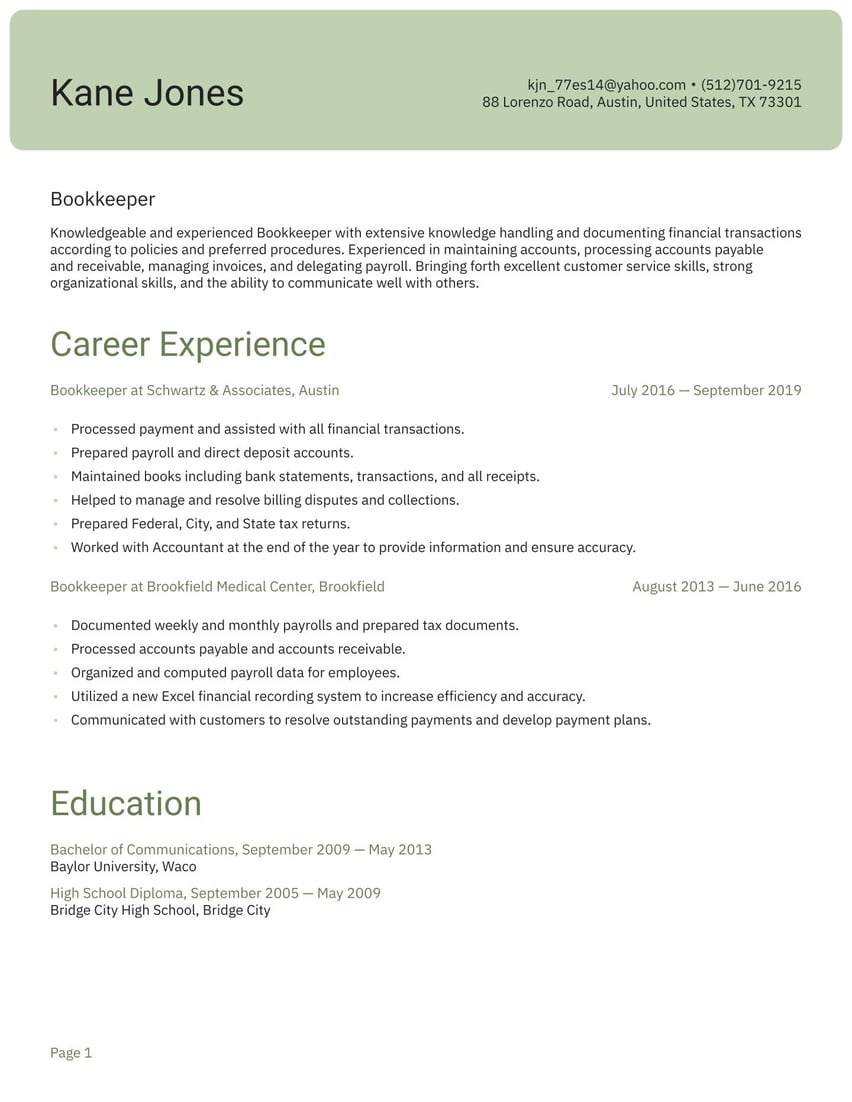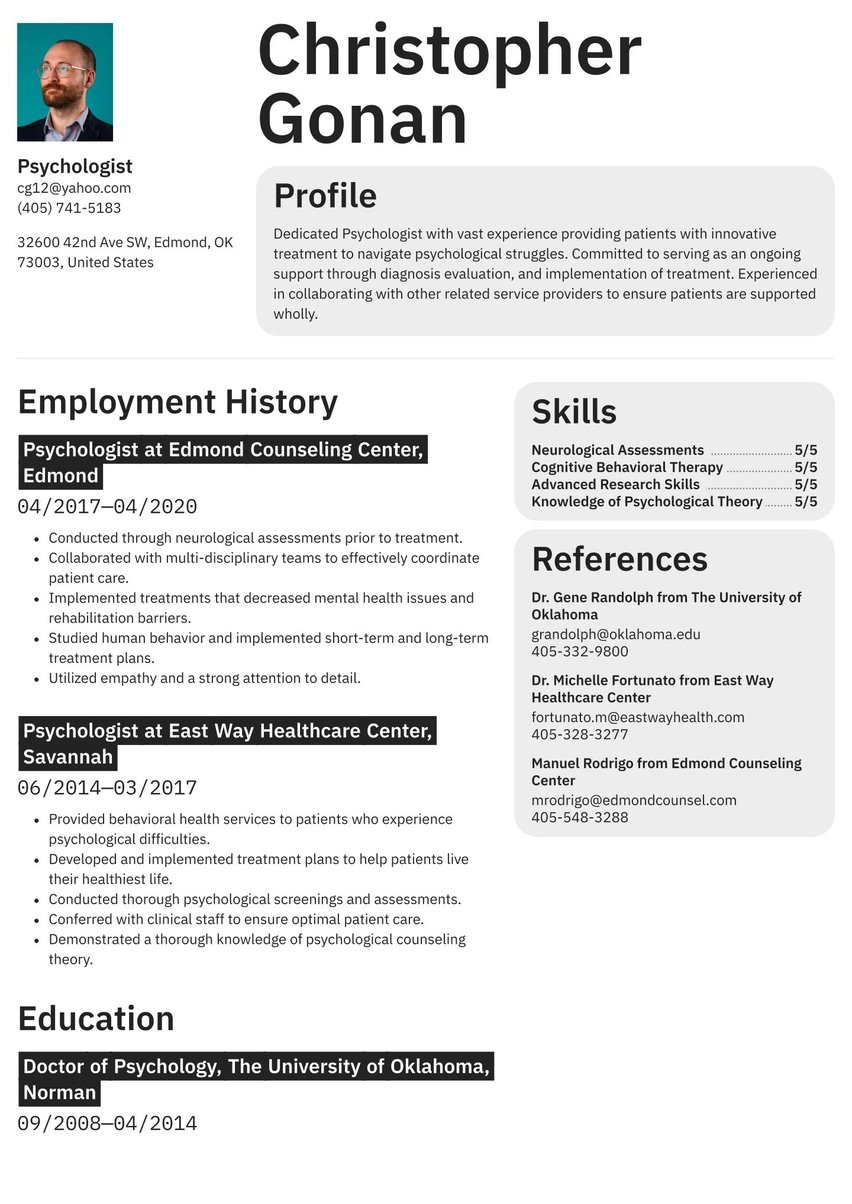As a bartender, you’re a professional with creative flair and unparalleled customer service skills. Now, it’s time to let that shine through in your resume.
Bartender resume examples by experience level
Bartending can be a fun and rewarding hospitality job, but to get the right bartender job for you, you first have to impress the employer just as you impress your customers with your mixology skills. It takes an entirely different mindset to craft a professional resume than a cocktail, so let us help you!
Resume guide for a bartender resume
Achieve more success with Resume.io. Our guides and resume examples cover over 500 professions, and our resume builder makes creating a compelling resume easier than ever.
This resume guide and corresponding bartender resume example will cover the following:
- How to write a bartender resume
- Choosing the right resume format for bartending
- How to add your contact information
- Using summaries
- Adding your bartending experience
- Listing education and relevant experience
- Picking the right resume design/layout
- What the bartender market looks like and what salary you can expect
How to write a bartender resume
Before you mix a drink, you need the ingredients. That follows for your bartender resume as well. Your resume should contain the following sections:
- The resume header
- The resume summary (aka profile or personal statement)
- The employment history section
- The resume skills section
- The education section
The same way you chat with customers to show off the vibe of your bar and sell your drinks, your resume serves as a unique pitch. To craft the best resume, find as much information as possible about the bar or restaurant to which you're applying. When you understand the company's needs, you can showcase how you're the right person for the job. To do this effectively, stick with this formula:
- Highlight accomplishments instead of just responsibilities. Everyone has a general idea of what a bartender does, but what sparkle did you bring to the job? Keep this in mind throughout every section of your resume.
- Tailor your resume for each job application you submit. That means adjusting the style and tone to that of the company in the same way you likely adjust your communication based on your customer and their needs.
- Use a resume template that's eye-catching yet still professional.
- Optimize your resume with the right keywords so whoever is reading — whether a human or a system — understands right away what you bring to the table.
Choosing the right resume format for a bartender
Are you a full-time bartender? Are you working a few nights a week for some extra cash? Did you think it would be a fun retirement job? The answers to these questions will help determine the best resume format for you.
Typically, we recommend reverse chronological order because it makes life easy for recruiters who want to know what you’ve done lately. If your work history doesn’t follow a straight path or you're just beginning your pivot into bartending, you may consider a functional resume or a hybrid style, in which you focus more on your skills and attributes than your experience.
Spend time time looking at the various resume templates in our resume builder and select the format that suits you best. There are plenty of versions of each format available to view as resume examples.
When it comes to design, you want to show off a little flair while still showing your professionalism. A modern or creative layout can be a great place to start.
Include your contact information
Bartenders love their regulars, but the first step in setting up that relationship is an introduction. Your resume's header is essentially an introduction on paper: it's where you share your name and contact information with prospective employers.
It's most important to keep it easily accessible and legible, while remaining professionally designed. Here are a few tips:
- Full name & title. List your first and last name as well as the title of the role you are pursuing.
- Professional email address. Use a clean format like [email protected]. Don’t use a quirky, unprofessional email address.
- Phone number. List a number where you can be readily contacted, with a professional voicemail greeting and a voicemail box that's active and not full.
- Location. List only your city and state; don’t list your street address or zip code. That's both outdated and can be unsafe.
- LinkedIn. If you have a LinkedIn profile and it's active and relevant, feel free to include it here.
Don’t include:
- Date of birth: This isn't necessary and could potentially lead to age discrimination.
- Personal details: Marital status, social security number, passport number, etc. can all be left off.
Michael Johnson, hoping to become a bartender
123 Park Avenue
New York, NY
(917) 347-1212
DOB 11/26/1984
Make use of a summary
Personality plays a big role in bartending. Some patrons like to get to know their bartenders. They want to be where everybody knows their name! In this section, you have a chance to illustrate your personality and style behind the bar. Replace a resume objective with a resume summary (also known as a resume profile or professional profile) because it offers a better opportunity to show off who you are. Your cover letter is another place to show off who you are, but try not to repeat information. You want to say as much as you can in the little space you have.
In three to five sentences, you should describe your biggest success. Maybe you developed a drink that became a big favorite or increased the number of regulars who came into the bar. Use strong, descriptive words to explain how you encourage repeat business or stay calm and personable as you handle a three-deep bar on a Saturday night.
The summary occupies prime space at the top of your resume, so make the most of it — don't just repeat information that's already elsewhere on your resume. Demonstrate your unique value proposition by drawing recruiters in with your upbeat personality and highlighting the key attributes that show your qualifications and accomplishments as a bartender.
Need inspiration for your summary? You may benefit from checking out our other
You can find adaptable bartender resume example summaries below:
Bartender with extraordinary customer service skills and a motivated attitude. Three years of experience waiting tables and passionate about taking on bartender responsibilities. Undergoing extensive self-education about mixology and drink combinations. Dedicated to providing customers with a warm and welcoming environment.
Bartender with 5+ years of extraordinary customer service skills and a motivated attitude. Knowledgeable about drink combinations and committed to serving with a smile. Adept at maintaining a clean and organized bar area and dedicated to providing customers with a warm and welcoming environment.
Experienced Bartender with over 10 years of experience delighting customers and ensuring success of bar operations. Deeply knowledgeable about drink combinations and committed to serving with a smile. Adept at leading shifts and fostering collaboration to maintain a clean and organized bar area and provide customers with a warm and welcoming environment.
Outline your bartender work experience
The employment history of your bartender resume is the place to make the most of your years of experience. Any hospitality or food service job you have held is a resume builder and should take up the most space in your work experience section. Only go about 10-15 years back, and give the most space to any bartending experience you have. These jobs attest to your ability to please customers, work with point-of-sales (POS) systems, and many other skills, so include them here.
Consider all the skills you use on the job when you write bullet points for each position and make sure you include action verbs that highlight your go-getter nature. A great bartender resume highlights a candidate’s ability to provide top-notch customer service and drink service. An ideal candidate is experienced in food and beverage environments and has a focus on customer satisfaction. Your resume should showcase your devotion to customer satisfaction and your ability to problem-solve when necessary.
Use details and data when appropriate to illustrate what you achieved at previous jobs. Simply listing your responsibilities in your job descriptions is not enough. Share what you've done in the past to let the hiring manager know how you will improve customer service and make their bar a destination.
As an example, imagine a bartender resume that reads:
- "Served drinks to customers."
- "Provided excellent customer service."
- "Used extensive drink knowledge to create drinks for customers."
Sure, it's clear what your job entailed — but that could also fit any bartender in any bar. Check out what happens when you get specific:
- "Crafted and served drinks to 100+ customers per night in high-end, luxury cocktail lounge."
- "Provided excellent customer service, earning the highest tips on the team and receiving recognition from management."
- "Leveraged extensive beverage knowledge to memorize and recreate 20 specialty drinks while also offering creative suggestions to patrons."
Take a look at the employment history resume sample below:
Bartender at The West End , New York
March 2021 - March 2024
- Greeted bar guests with a friendly and helpful attitude at all times.
- Helped to realize continual yearly increases in drink sales, achieving 10% increase 2022-2023.
- Provided guests with drink suggestions and menu information. Kept up with popular new drinks and stay well acquainted with countless drink recipes and mixing techniques, including 30 in-house specialty drinks.
- Maintained a clean and orderly bar.
- Managed bar inventory and placed orders as needed.
- Communicated with vendors and established strong working relationships with them.
- Handled difficult and inappropriate customers with grace and professionalism.
- Worked well with other bar and restaurant staff.
Bartender at Medicci's, New York
July 2017 - April 2020
- Served as a hospitable and fast-working bartender in one of the city's top high-end restaurants, serving 100+ patrons a shift.
- Provided bar patrons with optimal customer service, earning regular recognition from leadership.
- Maintained an up-to-date knowledge of beverage offerings and mixing techniques.
- Carried on friendly conversations with patrons and answered any questions or concerns to the best of my ability.
- Worked in a collaborative manner with other restaurant employees to ensure outstanding customer experiences.
Server and Bar Back at The White Cat, New York
August 2014 - June 2017
- Waited on tables, taking food and drink orders in this high traffic pub.
- Served upwards of 400+ customers on weekends.
- Memorized orders and aimed to provide fast and quality service to all visitors.
- Acted as a support to the bartender by creating drinks and helping to maintain and stock the bar when necessary.
- Utilized excellent listening skills and followed directions as given.
How to write a bartender resume with no experience
When creating a bartender resume without direct industry experience, it's essential to emphasize your transferable skills (especially any related to customer service or sales) and your passion for the food and beverage industry.
Focus on your educational background in sales or marketing, detailing any industry-relevant courses, workshops, or training programs you've attended.
Most importantly, showcase transferable skills that will be pivotal in a bartender role. For instance, if your experience includes being a server in a restaurant, highlight how this role honed your customer service and communication abilities, which are vital as a bartender. Similarly, working in a restaurant requires you to remember large orders and menu items, which is a skill you'll rely on when tending bar.
If you have personal interests in the industry — like extensive wine knowledge or a penchant for home brewing — it may be worth including it on your resume to further underscore your enthusiasm.
Adding these elements to your resume will illustrate your passion and potential as a bartender, even if you don't (yet) have direct experience.
Optimize for the ATS
An applicant tracking system, or ATS, is a system companies use to collect and manage applications. Advanced systems may use algorithms to help screen resumes for keywords that are aligned with the job description, then pass forward those that rank highest.
For example, a bartender job posting may include the following requirements:
- “Bartending experience"
- "Strong customer service skills"
- "Ability to thrive in a fast-paced environment"
Your resume profile summary, when integrating the keywords, could read:
“Experienced bartender with 5 years of success in fast-paced hospitality environments. Strong customer service skills, able to tailor communication to each customer's unique needs. Quick learner and passionate about mixology."
While these systems may be less commonly used in bars and other hospitality jobs, where you are more likely to hand in a resume in person, it's still worth targeting your resume keywords.
Include the relevant key skills that make you a great bartender
In the skills section of your bartender resume, you have the chance to display your greatest abilities. Try to pick your highest-level skills to distinguish yourself from other jobseekers.
Patrons often like to talk to bartenders, so your communication skills — especially your ability to listen as you work your mixology magic — are key. Communication skills are considered soft skills, much like customer service skills or organizational prowess.
You'll also want to include hard skills, those that can be demonstrated and measured. For example, hard skills for a bartender may include usage of specific equipment, POS systems, or methodologies.
Analyze the bartender job description for the position you seek and match the skills listed there when you put together this section. Remember that each job is a bit different, so your resume should be a fluid document that you personalize for each bartending job. Swap out skills accordingly.
Consider developing a list of all the skills in your repertoire. Highlight those that you need to be a successful bartender. When the bar is busy, you must be quick but accurate, attentive, and constantly multitasking. During down times, you should be managing inventory, cleaning, and restocking the bar area. If you seek a job as a lead bartender, you will be responsible for managing others as well, so don’t neglect any past management experience when you craft your skills section.
The resume builder offers several pre-written key skills to choose from with proficiency ranges you can set. You can also write in your skills.
Here’s what the skills box looks like in our bartender resume template.
- Bar Terminology
- Memorization Techniques
- Excellent Customer Service
- Knowledge of Flavor Combinations
- Advanced Communication
- Motivated Attitude
However, your resume's skills section isn't the only place to add your key skills. Instead, try to weave them throughout your resume by demonstrating the skills in action. Then enhance the credibility of these skills by providing specific examples and achievements.
For example, in your work experience section and professional summary, highlight your
- Customer service skills by quantifying the average number of customers served or drinks made, as well as any recognition you've received for customer satisfaction
- Teamwork experience by sharing how you've worked on a team to keep a bar running, or any leadership roles you've held
- Product knowledge by demonstrating your role in learning or creating specialty drinks
Look to the job description as a guide for what key skills to include.
Detail your education & relevant bartender certifications
The education section of your bartender resume is a must; however, bartending requires a specialized set of skills that you can learn on the job. Some choose to attend bartending school and others may have hospitality-related degrees, but a high school diploma is typically the minimum required education.
Even if your degree is not related to the hospitality field, list it here. Earning a college degree shows you have follow-through and perseverance.
If you have just completed bartending school and do not yet have any professional experience in the field, consider moving this section up since it highlights your major qualification for a bartender job. If you are a career-changer, consider using a functional resume that will highlight your education and related experience from a different field.
Don't forget to include training or certifications you've received, including:
- Training and certifications. Courses, workshops, or even webinars that enhance your bartending skills.
- Apprenticeships. If you worked under a more experienced bartender, that's great education.
- Professional development. Are you a member of any food and beverage associations like the NBA or IBA? That shows your dedication and passion for the field, so make sure you list it.
See the bartender resume sample content below.
Associate of Culinary Arts, Hunter College, New York
January 2012 - May 2014
Pick the right resume layout and design for a bartender resume
Bartending is people-oriented and creative, so you want your bartender resume design to reflect those attributes. Use our field-tested Creative resume templates to get you started (for more upscale and serious bars, restaurants, or hotels, check out our Professional category).
You can choose to customize them, but remember these helpful tips:
- Your first goal is to keep it easy-to-read, so no funny fonts
- Don’t get cute with the section titles — hiring managers want to find your information quickly
- Alter your line lengths to leave ample white space
- A pop of color can show personality, but don't go overboard
- Always have a friend or colleague proofread your resume before sending.
Our field-tested resume templates provide a great shortcut to building an excellent bartender resume.
Bartender job market and outlook
Bartender jobs remain fairly steady, "projected to grow 3% from 2022 to 2032, about as fast as the average for all occupations," according to the U.S. Bureau of Labor Statistics (BLS). That means that while jobs may not be in the highest demand, there is likely to be continuous opportunity for those looking to tend bar.
- The BLS anticipates roughly 113,500 bartender job openings to come available each year over the next decade. Much of these roles will open due to workers leave the industry or exiting the workforce altogether (to retire, for instance).
- In 2022, the BLS reported an estimated 641,300 bartender jobs in the United States alone.
What type of salary you can expect in bartending
Per the BLS, bartenders earned a median hourly wage of $14.12 as of 2022. The highest ten percent of bartenders, however, earned over $27.50 per hour.
Of course, a bartender in a high-end, luxury lounge or hotel will likely earn more than a bartender in a neighborhood dive. Much of a bartender's earnings also come from tips, which are variable.
Bartender text-only resume example
Profile
Experienced Bartender with extraordinary customer service skills and a motivated attitude. Knowledgeable about drink combinations and committed to serving with a smile. Adept at maintaining a clean and organized bar area and dedicated to providing customers with a warm and welcoming environment.
Employment history
Bartender at The West End , New York
March 2021 - March 2024
- Greeted bar guests with a friendly and helpful attitude at all times.
- Helped to realize continual yearly increases in drink sales, achieving 10% increase 2022-2023.
- Provided guests with drink suggestions and menu information. Kept up with popular new drinks and stay well acquainted with countless drink recipes and mixing techniques, including 30 in-house specialty drinks.
- Maintained a clean and orderly bar.
- Managed bar inventory and placed orders as needed.
- Communicated with vendors and established strong working relationships with them.
- Handled difficult and inappropriate customers with grace and professionalism.
- Worked well with other bar and restaurant staff.
Bartender at Medicci's, New York
July 2017 - April 2020
- Served as a hospitable and fast-working bartender in one of the city's top high-end restaurants, serving 100+ patrons a shift.
- Provided bar patrons with optimal customer service, earning regular recognition from leadership.
- Maintained an up-to-date knowledge of beverage offerings and mixing techniques.
- Carried on friendly conversations with patrons and answered any questions or concerns to the best of my ability.
- Worked in a collaborative manner with other restaurant employees to ensure outstanding customer experiences.
Server and Bar Back at The White Cat, New York
August 2014 - June 2017
- Waited on tables, taking food and drink orders in this high traffic pub.
- Served upwards of 400+ customers on weekends.
- Memorized orders and aimed to provide fast and quality service to all visitors.
- Acted as a support to the bartender by creating drinks and helping to maintain and stock the bar when necessary.
- Utilized excellent listening skills and followed directions as given.
Skills
- Bar Terminology
- Memorization Techniques
- Excellent Customer Service
- Knowledge of Flavor Combinations
- Advanced Communication
- Motivated Attitude
Education
Associate of Culinary Arts, Hunter College, New York
January 2012 - May 2014
Key takeaways for building a bartender resume
Bartenders are more than just mixologists — they need excellent customer service and listening skills, among others. It's imperative to display your broad skill set on your resume, but the right format will depend on your employment history and current situation. However, any hospitality or customer service experience will increase your desirability as a bartending prospect.
To make the process easier, take advantage of the resources and our online resume builder at Resume.io and let us help you create an eye-catching resume in no time.


.jpg)

.jpg)
